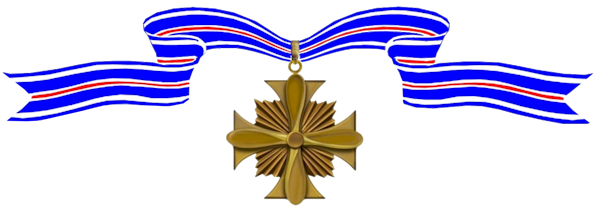Jay Zeamer never successfully checked out as a pilot in either the B-24 to which he was initially assigned, or a B-17 which he subsequently flew. As “odd-man-out,” he assembled a crew of miss-fits no one else would fly with, appropriated a beat-up bomber initially intended to be used only for parts, and built an air crew that became known for their combat fervor as the “Eager Beavers.” In the action that earned Zeamer the Medal of Honor, his bombardier, Raymond Sarnoski also earned the Medal of Honor. All other members of the crew received Distinguished Service Crosses which, when combined with the eight Purple Hearts earned on that mission, made the “Eager Beavers” the most highly decorated air crew in American air combat history.

–
Cemetery:
Awards Received
-

Silver Star
-

Silver Star
-

Medal of Honor
-
Silver Star
Service:
United States Army Air ForcesRank:
First Lieutenant (Air Corps)Batallion:
65th Bombardment SquadronRegiment:
43d Bombardment Group (H)Division:
5th Air ForceAction Date:
April 12, 1943
Headquarters, 5th Air Force, General Orders No. 123 (1943)The President of the United States of America, authorized by Act of Congress July 9, 1918, takes pleasure in presenting a Bronze Oak Leaf Cluster in lieu of a Second Award of the Silver Star to First Lieutenant (Air Corps) Jay Zeamer (ASN: 0-383971), United States Army Air Forces, for gallantry in action against the enemy while serving as Pilot of a B-17 Flying Fortress Bomber of the 403d Bombardment Squadron, 43d Bombardment Group (Heavy), FIFTH Air Force, in aerial operations over the Rabaul Area, New Britain, in the Southwest Pacific Theater of Operations, on 12 April 1943. The gallant actions and dedicated devotion to duty demonstrated by First Lieutenant Zeamer, without regard for his own life, were in keeping with the highest traditions of military service and reflect great credit upon himself and the United States Army Air Forces.
-
Silver Star
Service:
United States Army Air ForcesRank:
First Lieutenant (Air Corps)Batallion:
403d Bombardment SquadronRegiment:
43d Bombardment Group (H)Division:
5th Air ForceAction Date:
November 20, 1942
Headquarters, 5th Air Force, General Orders No. 63 (1943)The President of the United States of America, authorized by Act of Congress July 9, 1918, takes pleasure in presenting the Silver Star to First Lieutenant (Air Corps) Jay Zeamer (ASN: 0-383971), United States Army Air Forces, for gallantry in action against the enemy while serving as Pilot of a B-17 Flying Fortress Bomber of the 403d Bombardment Squadron, 43d Bombardment Group (Heavy), FIFTH Air Force, in aerial operations over Rabaul Harbor, New Britain, in the Southwest Pacific Theater of Operations, on 20 November 1942. On that date First Lieutenant Zeamer flew down over Rabaul for a look at the harbor when a flight of Zeroes was seen taking off from a nearby airdrome. Maneuvering the bomber into the clouds, they avoided contact and eluded 15 to 40 enemy Zeroes. Returning a long the coastline, they sighted a fresh flight of Zeros flushed from Buna. In the battle that followed at least two of the enemy Zeros were shot down in flames. The gallant actions and dedicated devotion to duty demonstrated by First Lieutenant Zeamer, without regard for his own life, were in keeping with the highest traditions of military service and reflect great credit upon himself and the United States Army Air Forces.
-
Medal of Honor
Service:
United States Army Air ForcesRank:
Major (Air Corps), [then Captain]Batallion:
65th Bombardment SquadronRegiment:
43d Bombardment Group (H)Division:
5th Air ForceAction Date:
June 16, 1943
War Department, General Orders Date: January 14, 1944The President of the United States of America, in the name of Congress, takes pleasure in presenting the Medal of Honor to Major (Air Corps), [then Captain] Jay Zeamer, United States Army Air Forces, for conspicuous gallantry and intrepidity in action above and beyond the call of duty while serving with the 65th Bombardment Squadron, 43d Bombardment Group (H), 5th Air Force. On 16 June 1943, Major Zeamer volunteered as pilot of a bomber on an important photographic mapping mission covering the formidably defended area in the vicinity of Buka, Solomon Islands. While photographing the Buka airdrome. his crew observed about 20 enemy fighters on the field, many of them taking off. Despite the certainty of a dangerous attack by this strong force, Major Zeamer proceeded with his mapping run, even after the enemy attack began. In the ensuing engagement, Major Zeamer sustained gunshot wounds in both arms and legs, one leg being broken. Despite his injuries, he maneuvered the damaged plane so skillfully that his gunners were able to fight off the enemy during a running fight which lasted 40 minutes. The crew destroyed at least five hostile planes, of which Major Zeamer himself shot down one. Although weak from loss of blood, he refused medical aid until the enemy had broken combat. He then turned over the controls, but continued to exercise command despite lapses into unconsciousness, and directed the flight to a base 580 miles away. In this voluntary action, Major Zeamer, with superb skill, resolution, and courage, accomplished a mission of great value.


